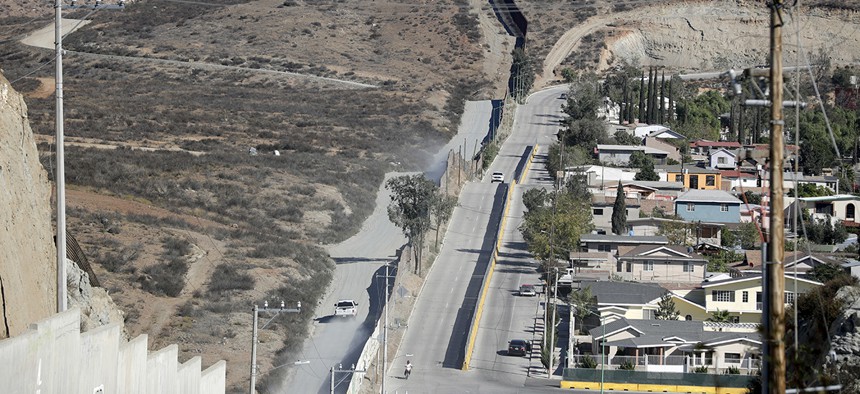Border Walls Work in Cities, DHS Officials Tell Lawmakers

A Border Patrol vehicle drives by the border fence in Tecate, Calif., left, along the metal barrier that lines the border Wednesday, Nov. 9, 2016, seen from Tecate, Mexico. Gregory Bull/AP File Photo
Lawmakers want a higher-tech border patrol, but a watchdog agency is concerned CBP isn't measuring how useful its technology is.
If Homeland Security Secretary John Kelly's spring prediction comes true, building a physical wall that spans the entire U.S. Mexican border is "unlikely."
What's more likely is a mix of advanced surveillance technology, a fortified physical barrier, and agents cracking down on people trying to enter or transmit drugs into the country illegally, U.S. Border Patrol's acting Chief Scott Luck said during a House hearing Tuesday. In urban areas, the wall might take on more importance in keeping out illegal entrants or contraband, Luck said.
During the Border and Maritime subcommittee hearing, lawmakers grilled Homeland Security officials about their approach to technology, highlighting concerns that Customs and Border Protection does not adequately document how it uses new technology.
» Get the best federal technology news and ideas delivered right to your inbox. Sign up here.
“Instead of focusing solely on the gadgets and gizmos and the many repeated failures of the CBP procurement process, I think it is important to think strategically about the decision-making process of those who aim to exploit our border for illicit purposes,” Rep. Martha McSally, R-Ariz., said in prepared opening remarks.
Here are a few takeaways from that discussion:
CBP has been dinged for not properly assessing how useful technology is.
CBP deployed new systems including remote video surveillance at the Arizona border, but it could do more to figure out how much they contribute to border security efforts, Rebecca Gambler, director of the Government Accountability Office's Homeland Security and Justice division, testified Tuesday. But the agency is improving by maintaining more current schedules for technology deployment and has also recently started documenting when recordings or other data helps agents seize contraband, she added.
Lawmakers are concerned that CBP's measurement problems will stymie high-tech border protection.
Rep. Lou Correa, D-Calif., pressed Gambler on whether CBP's challenges in documenting how useful technology is could delay Trump's vision for a fortified border, including the wall itself.
“We do think it’s important for CBP to put metrics in place both for tactical infrastructure to include the fencing," Gambler said. The GAO concluded that CBP needs to be able to show why it's making investments and why it’s choosing to put certain technologies or assets in certain places.
CBP wants drones that spot human movement better.
CBP acting Executive Director of Operations Dennis Michelini told lawmakers the agency expects to continue deploying the Vehicle and Dismount Exploitation Radar, known as VADER, on unmanned drones. The system can detect human movement on the ground from aerial vehicles. Installing VADER on manned vehicles is still "a few years out," he said.
The wall might be more robust in urban areas.
Asked where a physical border wall is most beneficial, Luck pointed to urban areas but emphasized that walls would only be a part of the strategy. In California, for instance, physical borders help "stop the flow, helps displace the traffic so we can use technology assets, situational awareness to detect that traffic," he said.
Rep. Will Hurd, R-Texas, asked Luck for vision for a border patrol of the future. It's "the right mixture of technology ... that informs and talks to all the other component pieces that we have within CBP," Luck said. In an ideal system, "information is shared immediately to all components and agents and officers who need it.”
NEXT STORY: IRS Pilot Lets You Settle Tax Disputes From Home





